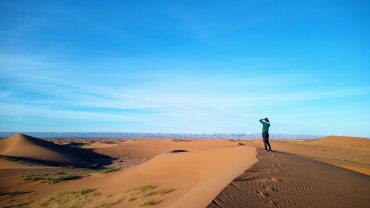Rainforests are among the most fascinating and challenging environments on the planet. Their dense vegetation, diverse wildlife, and unpredictable weather can present numerous obstacles for even the most experienced adventurers. The Wild Globe Expeditions team has spent years exploring and working in some of the world’s most remote rainforests. Here, we share essential tips and techniques to help you thrive in these lush, yet demanding, ecosystems.
Understanding the Rainforest Environment
Know the Climate
Rainforests are typically hot and humid, with frequent rain showers. Understanding the climate is crucial for preparing the right gear and clothing. Learn more on this from our blog “What to wear on your jungle trek”.
Recognise the Terrain
Rainforests feature diverse terrain, from dense undergrowth and swampy areas to steep hillsides. Familiarize yourself with the types of terrain you’ll encounter to better prepare for your journey.
Essential Gear for Rainforest Survival
Quick-dry clothing
Waterproof jackets, pants, and boots will make you sweat and keep you wet, causing issues like fungal infections. It is better to accept that you will be wet during the day and wear comfortable, lightweight, quick-dry clothing which can breathe and dry out in moments of sun or from your body heat.
Durable Footwear
Sturdy hiking boots with good drainage and traction are essential. Avoid waterproof boots as these will keep your feet wet and cause infections.
Navigation Tools
Carry a GPS device and compass. Maps may not be available for many rainforest areas, but if you can get hold of one then that will be valuable. These tools are essential for navigating through dense vegetation where trails can be hard to follow. If you are in an area with trails try to build up a mental map, or even draw one, to help you make sense of the land.
Insect Protection
Insects can be more than just a nuisance when they might be carrying diseases. Use insect repellent, wear long-sleeved clothing, and sleep under mosquito nets to protect against bites and potential diseases.
Water Purification System
Clean drinking water is crucial. A portable water filtration system ensures you have access to safe water, reducing the risk of waterborne illnesses. There are many options available including pump action filters, gravity filters and filter bottles.
Survival Techniques
Building Shelter
Shelter is essential to protect you from the elements and insects. Learn to build a basic shelter using available materials like branches and leaves and try to do so in a way that minimises the impact on your environment. Dead wood can be used to build a shelter rather than cutting down live trees, and avoid stripping a palm of all its leaves to thatch the roof. If you cut the heart leaf, the palm will die. It is better to carry a tarp and hammock so that you can create a shelter quickly and easily without causing damage to the environment. It will also be a lot more comfortable, and probably protect you from the rain better!
Finding Food
While rainforests are abundant with food sources, identifying safe options is key. Learn to recognise edible plants and fruits and only eat ones that you can 100% positively identify, there are many toxic plants in the rainforest as well. On our expeditions we do not hunt or trap wild animals because we believe strongly in protecting the ecosystem and enjoying it as visitors.
Starting a Fire
A fire is critical for warmth, cooking, and signaling for help. Carry waterproof matches or a lighter, and learn techniques for starting a fire with wet wood, such as creating feather sticks or using natural rubber harvested from a rubber tree. Cotton wool dipped in vaseline makes a fantastic firestarter and can be lit using a ferro-rod.
Staying Hydrated
Never drink directly from rivers or streams without purifying the water. Use your water purification system, or boil it over the fire to make sure it is safe to drink.
Navigating Safely
Always mark your trail to avoid getting lost. Use natural landmarks such as recognising big iconic trees, rivers and rocks and stay oriented with your compass or GPS. Remember to turn around and see how the trail looks from the other direction occasionally (you could even take photos to document the return journey). If you do get lost, staying put and signaling for help is often the safest option, or mark a central location you can keep returning to and explore outwards in a star shape to try and recognise something familiar to get back on your trail.
Health and Safety Tips
Avoiding Dangerous Wildlife
While many rainforest animals are harmless, and generally not looking to do us any harm, some can be dangerous when threatened. Learn to identify venomous snakes, insects, and plants, and maintain a safe distance from wildlife. A lot of animals rely on their excellent camouflage to avoid predators and ambush prey, so make sure you look very carefully where you’re putting your feet.
First Aid Knowledge
Carry a well-stocked first aid kit and know how to treat common injuries, such as cuts, bites, and stings. Learn basic first aid skills to handle emergencies.
Managing Fatigue and Dehydration
The heat and humidity can quickly lead to exhaustion. Take regular breaks, stay hydrated, and consume high-energy snacks to maintain your stamina. It is a good idea to add electrolyte powders or tablets into your water to replace the minerals you lose through your sweat.
Eco-Friendly Practices
Leave No Trace
Protect the delicate rainforest ecosystem by following Leave No Trace principles. Carry out all your rubbish, avoid damaging plants, fully extinguish fires and remove their scars and always look for ways to minimise your footprint. Read more about this in our blog “Leave no trace”.
Respect Wildlife
Observe animals from a distance and avoid feeding them. Respect their natural behaviors and habitats to ensure both your safety and theirs.
Use Biodegradable Products
Use biodegradable soaps and other products to minimise environmental impact. Avoid polluting water sources and dispose of waste responsibly.
Surviving in the rainforest requires preparation, knowledge, and respect for the environment. With these tips and techniques from Wild Globe Expeditions, you can navigate the challenges of the jungle and enjoy the unparalleled beauty and adventure it offers. Equip yourself with the right gear, learn essential survival skills, and always prioritise safety and environmental responsibility. Happy exploring!
For more information on staying safe and healthy in the rainforest, read our blog “Must have pieces of kit to take on your jungle expedition”.
Keen to experience the jungle for yourself? Join our Ultimate Jungle Expedition. On this trip you will be led and instructed by a UK expedition leader and a local indigenous guide.




Comment (0)